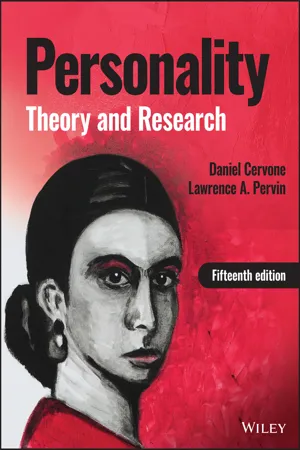Psychology
John Watson
John Watson was an influential American psychologist known for his pioneering work in behaviorism. He is often referred to as the founder of behaviorism and is famous for his "Little Albert" experiment, which demonstrated how fear could be conditioned in a young child. Watson's emphasis on observable behavior and the rejection of introspection had a profound impact on the field of psychology.
Written by Perlego with AI-assistance
Related key terms
1 of 5
11 Key excerpts on "John Watson"
- eBook - PDF
Personality
Theory and Research
- Daniel Cervone, Lawrence A. Pervin(Authors)
- 2022(Publication Date)
- Wiley(Publisher)
Watson, Pavlov, and Classical Conditioning Watson’s Behaviorism John B. Watson (1878–1958) was the founder of the approach to psychology known as behavior- ism. He began his graduate study at the University of Chicago in philosophy and then switched to psychology. He took courses in neurology and physiology and began to do biological research with animals. During the year before he received his doctorate, Watson had an emotional break- down and had sleepless nights for many weeks. He described this period as causing him to become interested in the work of Freud (Watson, 1936, p. 274). He eventually completed his dis- sertation, which caused him to develop a particular attitude regarding the use of human subjects: At Chicago, I first began a tentative formulation of my later point of view. I never wanted to use human subjects. I hated to serve as a subject. I didn’t like the stuffy, artificial instructions given to subjects. I always was uncomfortable and acted unnaturally. With animals I was at home. I felt that, in studying them, I was keeping close to biology with my feet on the ground. More and more the thought presented itself: Can’t I find out by watching their behavior everything that the other students are finding by using O’s (human subjects)? Source: Watson (1936, p. 276). Table 9.1 Basic Points of Emphasis of Learning Approaches to Personality 1. Empirical research is the cornerstone of theory and practice 2. Personality theory and applied practice should be based on principles of learning 3. Behavior is responsive to reinforcement variables in the environment and is more situation specific than suggested by other personality theories (e.g., trait, psychoanalytic) 4. The medical symptom–disease view of psychopathology is rejected, and emphasis instead is placed on basic principles of learning and behavior change - eBook - PDF
History of Modern Psychology
A Global Perspective
- C. James Goodwin(Author)
- 2023(Publication Date)
- Wiley(Publisher)
Thus, he deserves the title “founder” of behaviorism. Second, by attacking introspective psychology directly and exposing its Achilles’ heel, its lack of objectivity, Watson contributed to the gradual shift from psychology as the study of immediate conscious experience to psychology as the study of behavior. By making observable and measurable behavior the dependent variable, rather than an introspective report, Watson ultimately helped place the field of psychology on firmer scientific ground. Third, Watson’s popularity with the general public suggests that his ideas struck a responsive chord with Americans. His belief that the environment could be arranged to shape someone’s future development was consistent with the American ideal that through proper child rearing and education, people could aspire to any goal. It was an especially appealing message in the 1920s, a time of prosperity in America and a time when average Americans were optimistic about their futures and had no comprehension that the Great Depression of the 1930s was just around the corner. Watson himself was a living example of this attitude, a poor farm boy who rose to the top of his profession twice—once in psychology and again in the business world. This message was much more inviting for average Americans than the one they were receiving from the mental testers. As you recall from Chapter 7, Terman and others were agitating for a meritocracy based on an IQ that was assumed to be largely innate. Finally, Watson’s behaviorism effectively bridged the gap between basic and applied psychology. Laboratory work in areas like conditioning and maze learning gradually became scientifically rigorous, thereby fulfilling the promise of a scientific psychology. At the same time, the possibilities for application, repeatedly stressed by Watson, also bore fruit as behaviorist ideas eventually influenced child rearing, education, industry, and even psychotherapy. - eBook - ePub
Personality Theories
Critical Perspectives
- Albert Ellis, Mike Abrams, Lidia Abrams(Authors)
- 2008(Publication Date)
- SAGE Publications, Inc(Publisher)
Image 10.3 John B. Watson (1878–1958)The psychology Watson espoused saw humans as just one type of organism that could be completely molded by conditioning. His 1913 manifesto plainly stated that conviction:Psychology as the behaviorist views it is a purely objective experimental branch of natural science. Its theoretical goal is the prediction and control of behavior. Introspection forms no essential part of its methods, nor is the scientific value of its data dependent upon the readiness with which they lend themselves to interpretation in terms of consciousness. The behaviorist, in his efforts to get a unitary scheme of animal response, recognizes no dividing line between man and brute. The behavior of man, with all of its refinement and complexity, forms only a part of the behaviorist’s total scheme of investigation. (p. 158)Watson seized upon the discoveries of Ivan Pavlov and his coworkers to advocate an entirely new method of understanding behavior. And behavior, he avowed, was all that needed to be understood. Watson’s tabula rasa (blank slate) view of the human mind became widely known and popularized by the mass media. A 1939 quotation from Time magazine makes clear that behaviorism was widely known as proposing that humans are all fundamentally the same. “Some researchers, such as Behaviorist John Broadus Watson, have tried to show that emotional endowments are all the same at birth and that differences appearing later are due to environment” (“Emotional Rats,” 1939).This same sentiment was expressed by Watson some years earlier in his behavioral creed:[W]e have no real evidence of the inheritance of traits. I would feel perfectly confident in the ultimately favorable outcome of careful upbringing of a healthy, well-formed baby born of a long line of crooks, murderers, thieves, and prostitutes. Who has any evidence to the contrary? Many, many thousands of children yearly, born from moral households and steadfast parents, become wayward, steal or become prostitutes, through one mishap or another of nurture. Many more thousands of sons and daughters of the wicked grow up to be wicked because they couldn’t grow up any other way in such surroundings. But let one adopted child who has a bad ancestry go wrong and it is used as incontestable evidence for the inheritance of moral turpitude and criminal tendencies. As a matter of fact, there has not been a double handful of cases in the whole of our civilization where records have been carefully enough kept for us to draw any such conclusions—mental testers, Lombroso [Cesare Lombroso, an Italian criminologist who thought that criminal tendencies are inherited], and all other students of criminality to the contrary notwithstanding. All of us know that adopted children are never brought up as one’s own. One cannot use statistics gained from observations in charitable institutions and orphan asylums. All one needs to do to discount such statistics is to go there and work for a while, and I say this without trying to belittle the work of such organizations. I should like to go one step further tonight and say, “Give me a dozen healthy infants, well formed, and my own specified world to bring them up in and I’ll guarantee to take any one at random and train him to become any type of specialist I might select—a doctor, lawyer, artist, merchant chief and, yes, even into beggar man and thief, regardless of his talents, penchants, tendencies, abilities, vocations, and race of his ancestors.” I am going beyond my facts and I admit it, but so have the advocates of the contrary and they have been doing it for many thousands of years. Please note that when this experiment is made I am to be allowed to specify the way they are to be brought up and the type of world they have to live in. (Watson, 1926, pp. 9–10) - eBook - PDF
- Duane Schultz(Author)
- 2013(Publication Date)
- Academic Press(Publisher)
l ï ï > BEHAVIORISM: THE BEGINNING INTRODUCTION We discussed several antecedents of the behaviorist movement that influ-enced John B. Watson in his attempt to construct a new school of thought for psychology. Watson recognized that founding was not the same as originating, and he described his efforts as a crystallization of current trends in psychology. Like Wilhelm Wundt, psychology's first promoter-founder, Watson set out deliberately to found a new school. This intent clearly sets him apart from others whom history now labels precursors of behaviorism. JOHN B. WATSON (1878-1958) Watson was born on a farm near Greenville, South Carolina, where his early education was conducted in a one-room schoolhouse. The family later moved into Greenville and the 12-year-old Watson attended public schools. He described himself as lazy and insubordinate, and never earned more than passing grades. His teachers remember him as indolent, argumentative, and not easily controlled. He grew up in what Bakan (1966) described as a state of semidelinquency. Watson got into fights and was arrested twice, once for shooting firearms within the city limits. It was not a promising beginning. Nevertheless, he entered Furman University in Greenville at the age of 16 with a firm plan for his future—he was going to become a minister. Many years earlier he had promised his mother, a devout Baptist, that he would follow the life of a clergyman. At Baptist-affiliated Furman Watson studied philosophy, mathematics, Latin, and Greek, and was expected to graduate in 1899 and enter Princeton Theological Seminary the following fall. A curious thing happened during Watson's senior year. One of his professors warned the students (perhaps jokingly, but that is not known for sure) that anyone who handed in a paper backward would fail the course. Watson took the professor up on the challenge, turned in his paper backward, and failed. - eBook - PDF
Personality
Theory and Research
- Daniel Cervone, Lawrence A. Pervin(Authors)
- 2018(Publication Date)
- Wiley(Publisher)
This is the strategy adopted by the behaviorist. Table 10.1 summarizes the basic points of emphasis in behaviorism that we have reviewed. With this background, we now begin our coverage of theories that were developed within this behavioral approach to psychological science. Specifically, we start where the approach itself began histori- cally, with the ideas of John Watson and the associated research contributions of Ivan Pavlov. Watson, Pavlov, and Classical Conditioning Watson’s Behaviorism John B. Watson (1878–1958) was the founder of the approach to psychology known as behavior- ism. He began his graduate study at the University of Chicago in philosophy and then switched to psychology. He took courses in neurology and physiology and began to do biological research with animals. During the year before he received his doctorate, Watson had an emotional break- down and had sleepless nights for many weeks. He described this period as causing him to become interested in the work of Freud (Watson, 1936, p. 274). He eventually completed his dis- sertation, which caused him to develop a particular attitude regarding the use of human subjects: At Chicago, I first began a tentative formulation of my later point of view. I never wanted to use human subjects. I hated to serve as a subject. I didn’t like the stuffy, artificial instructions given to subjects. I always was uncomfortable and acted unnaturally. With animals I was at home. I felt that, in studying Table 10.1 Basic Points of Emphasis of Learning Approaches to Personality 1. Empirical research is the cornerstone of theory and practice 2. Personality theory and applied practice should be based on principles of learning 3. Behavior is responsive to reinforcement variables in the environment and is more situation specific than suggested by other personality theories (e.g., trait, psychoanalytic) 4. - eBook - ePub
- Ludy T. Benjamin(Author)
- 2023(Publication Date)
- Wiley(Publisher)
So what was the legacy of Watson’s behaviorism in American psychology? Some scholars have argued that his narrowing of the field limited the development of psychology and closed off important areas for research that only reemerged in recent decades. Others argued that psychology’s progress as a science in the twentieth century was principally because of Watson, that he was the one figure who demanded a complete break with philosophy. Watsonian behaviorism strengthened the role of physiological processes in psychological explanations, expanded psychological methods, and made more evident the ties between animal and human behavior.Also key to the psychologies of Watson, Tolman, and Skinner was an unshakeable belief in the value of behaviorism for the betterment of humanity, something the Europeans grasped in the 1960s and beyond. Watson wrote in the 1920s that behaviorism was the foundation for saner living and that it offered men and women a prescription for a better life. Tolman was a social activist who used his behavioral science to address social and global problems. In the 1950s and later, Skinner argued that the changes in human behavior that were needed to produce a better world would come not from the physical or biological sciences but from a robust and systematic behavioral science. See Moore (2017 ) and Rutherford (2017 ) for a fuller explication of this topic.Finally, it is almost certain that cognitive psychology, the dominant subfield of experimental psychology today, is a stronger scientific field because it adopted many of the tenets of behaviorism in establishing its science. And Edward Tolman is a key link to that connection. David Carroll (2017 ) has described Tolman’s contribution to modern cognitive psychology as designing “clever experiments that would reveal cognitive processes in laboratory animals” (p. 217), this at a time when most psychologists refused to look at the inner life of rats or humans. We will look at Tolman’s legacy in the final chapter of this book.References
- Abramson, C. I. (Ed.) (2002). Selected papers and biography of Charles Henry Turner (1867–1923): Pioneer in the comparative and animal behavior movement. Lewiston, NY: Edwin Mellen Publishers.
- Abramson, C. I. (2003). Charles Henry Turner: Contributions of a forgotten African American to honey bee research. American Bee Journal, 143
- eBook - PDF
- Duane Schultz(Author)
- 2013(Publication Date)
- Academic Press(Publisher)
We now consider Watson's treatment of some of the traditional topics in psychology: instinct, learning, emotion, and thinking. 212 BEHAVIORISM: THE BEGINNING Instinct Watson's position on the role of instinct in behavior changed from an initial acceptance of instincts to a categorical denial of their existence in humans—the latter position announced in 1925. All those aspects of human behavior that seem instinctive, Watson argued, are in reality socially conditioned responses. With his position that learning is the key to understanding the development of human behavior, Watson became an extreme environmentahst. He went beyond just denying instincts and refused to admit that there were inherited capacities, temperaments, or talents of any kind. Those things that seem inherited depend on training that goes on mainly in the cradle. The behaviorist would not say: He inherits his father's capacity or talent for being a fine swordsman. He would say: This child certainly has his father's slender build of body, the same type of eyes . . . . And he would go on to say: —and his father is very fond of him. He put a tiny sword into his hand when he was a year of age, and in all their walks he talks sword play, attack and defense, the code of duelling and the like. A certain type of structure, plus early training— slanting —accounts for adult performance [J. B. Watson, 1930, p. 94]. This emphasis on the overwhelming influence of the environment, and its corollary that one can train a child to be whatever one wants him to be, was at least part of the reason for Watson's large public following. Learning Since, according to Watson, there are no instincts or inherited capac-ities or talents of any kind—the adult is strictly a product of childhood conditioning—learning plays a major role in behaviorism. Watson's views on learning showed a progressive change in the direc-tion of the incorporation of conditioning as a basic part of his system. - Tracy Henley(Author)
- 2018(Publication Date)
- Cengage Learning EMEA(Publisher)
Like Mary, Rosalie was from a prominent family and had sought to work with Watson following her gradu-ation from Vassar. The scandal was too much for Johns Hopkins: Watson was asked to resign, and he did. For all practical purposes, this marked the end of Watson’s academic career in psychology. He still wrote about and lectured on psychology, and revised many of his earlier works, but now he directed his ideas toward the general public rather than psycholo-gists. In the days before television and the Internet, his works now appeared in leading popular mag-azines such as Harper’s , the New Republic , McCall’s , and Cosmopolitan instead of in professional journals. Watson also spoke on many radio talk shows. Iron-ically then, Watson’s ideas were reaching a vastly larger audience, and his influence on psychol-ogy flourished. The following is a sample of titles of his articles and radio talks: “How We Think” (1926), “The Myth of the Unconscious” (1927), “On Reconditioning People” (1928), “Feed Me on Facts” (1928), “Why 50 Years from Now Men Won’t Marry” (1929), “After the Family—What?” (1929), “Women and Business” (1930), and “On Children” (1935). The last such article Watson wrote was titled “Why I Don’t Commit Suicide.” views on behaviorism. He began his now famous lecture, “Psychology as the Behaviorist Views It” (1913), with the following statement: Psychology as the Behaviorist views it is a purely objective experimental branch of natural science. Its theoretical goal is the prediction and control of behavior. Introspection forms no essential part of its methods, nor is the scientific value of its data dependent upon the readi-ness with which they lend themselves to interpretation in terms of consciousness. The Behaviorist, in his efforts to get a unitary scheme of animal response, recog-nizes no dividing line between man and brute. The behavior of man, with all of its refinement and complexity, forms only a part of the Behaviorist’s total scheme of investigation.- eBook - PDF
- Duane Schultz, Sydney Schultz, , , Duane Schultz, Sydney Schultz(Authors)
- 2015(Publication Date)
- Cengage Learning EMEA(Publisher)
Both human and animal behavior would be investigated, and psychologists would discard all mentalistic ideas and terms and use only behavior concepts such as stimulus and response. Psychology’s goal would be the prediction and control of behavior. Copyright 2016 Cengage Learning. All Rights Reserved. May not be copied, scanned, or duplicated, in whole or in part. Due to electronic rights, some third party content may be suppressed from the eBook and/or eChapter(s). Editorial review has deemed that any suppressed content does not materially affect the overall learning experience. Cengage Learning reserves the right to remove additional content at any time if subsequent rights restrictions require it. 222 Chapter 10 Behaviorism: The Beginnings Despite its appeal to some, however, Watson’s program was not embraced immediately or universally. At first, behaviorism received relatively little attention in the professional journals. Not until the publication of Watson’s 1919 book, Psychology from the Standpoint of a Behaviorist, did the movement begin to have a significant impact. One psychologist who disagreed with Watson was Mary Whiton Calkins. Questioning his rejection of introspection, she spoke for many psychologists who believed that certain psychological processes could be studied only by introspection. The arguments about introspection persisted for years, and Margaret Washburn went so far as to call Watson an enemy of psychology. Inevitably, support for Watson’s movement grew, particularly among younger psychologists, and by the 1920s universities were offering courses in behaviorism and the term was becoming acceptable in the professional journals. Among the older psychologists, William McDougall issued a public warning against behaviorism’s popularity, and Titchener complained that behaviorism had engulfed the country like a tidal wave. By 1930, however, Watson could proclaim proudly that behaviorism was so important that no university could avoid teaching it. - Claude E. Buxton(Author)
- 2013(Publication Date)
- Academic Press(Publisher)
Watson therefore opposed introspection because he thought there were other, more objective ways to study the phenomena of consciousness and thinking. This position is reflected in his remark that two hundred years from now, unless the introspective method is discarded, psychology will still be divided on 6. The Origins of Behaviorism: Antecedents and Proclamation 155 the question as to whether auditory sensations have the quality of 'ex-tension' (Watson, 1913b, p. 164). Watson was quite aware that by removing consciousness and intro-spection from psychology, he was freeing its practitioners to develop principles that were valid for other species as well as human beings. Psychology, he thought, had gone through a progression similar to that in evolutionary theory. While human beings were once seen as unique, they were now being viewed as part of the continuum of the animal kingdom (Watson, 1913b). At this point in his career, Watson clearly grouped people together with other animals, convinced that his behav-iorism applied equally to any species: The behavior of man and the behavior of animals must be considered on the same plane, (Watson, 1913b, p. 176). For Watson, the question of the relative contributions of heredity and environment was not yet a major focus. His publications were directed toward making the point that behavior, not consciousness, should con-cern psychologists. When he did discuss the heredity-environment is-sue, however, he was neither an extreme hereditarian nor an extreme environmentalist: Organisms, man and animal alike, do adjust them-selves to their environment by means of hereditary and habit equip-ments (1913b, p. 167). He was favorably disposed to Lamarck's evolu-tionary theory and therefore believed that the effects of environment could be incorporated into the genes and thereby passed on to succeed-ing generations (Watson, 1914, chap. 5). At this time, Watson did not focus on the means by which organisms learn.- eBook - PDF
- William O'Donohue, Richard Kitchener(Authors)
- 1998(Publication Date)
- Academic Press(Publisher)
These were points that the behaviorisms to follow would develop mor e fully . D . A SCIENCE OF BEHAVIO R Up to this point, we have described the historical, intellectual, and cultura l contexts from which Watsonian behaviorism evolved, some of its general char-acteristics, and three of its main features . We have not, however, described Wat-son's science per se . Although his science was largely underdetermined by be-haviorism as a system of psychology, it reveals still additional details taken to b e distinctive of it, albeit less central than those presented thus far . For this reason , we review his science more briefly, organizing it in terms of its purpose an d purview, its methods, and its systematic organization of behavior as a subjec t matter for a natural science . Throughout this material, we draw on example s taken from Watson's (1919, 1930) own analyses . 1 . Purpose and Purvie w As for the purpose and purview of psychology as the behaviorist views it , Watson (1919) wrote : Psychology is that division of natural science which takes human activity and conduct a s its subject matter. It attempts to formulate through systematic observation and experimen - 46 MORRIS AND TOD D tation the laws and principles which underlie man ' s reactions . Every one agrees tha t man's acts are determined by something, and that, whether he acts orderly or not, ther e are sufficient grounds for his acting as he does act, if only these grounds can be discov-ered . (p . 1 ) Here, again, we see that prediction-and-control was not, in itself, the goal o f Watson's science . For Watson (1919) : As a science psychology puts before her -self the task of unraveling the complex factors involved in the development o f human behavior from infancy to old age, and with finding the laws for the regu-lation of behavior (p . 8) .
Index pages curate the most relevant extracts from our library of academic textbooks. They’ve been created using an in-house natural language model (NLM), each adding context and meaning to key research topics.










